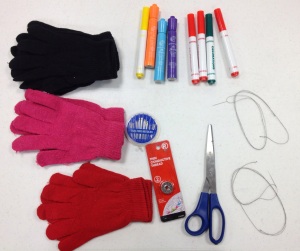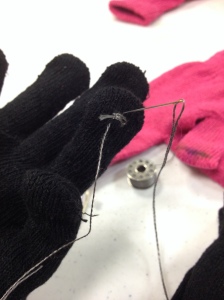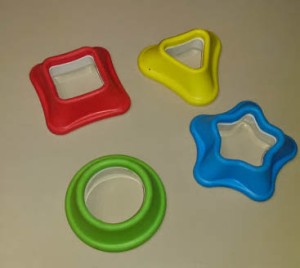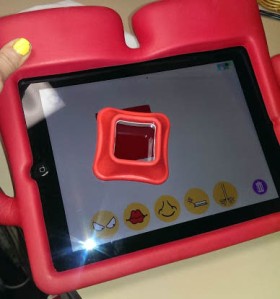Reviews
Products that have been tested.
Review: Tiggly Shapes
Other, Programs, ReviewsFirst things first: Tiggly Shapes are not robots. But they are still pretty great. I’ve discovered they are a great way to bring dimension to the flat tablet world. They also can be used in libraries pretty easily.
Basics:
- What are they? Tiggly Shapes are a set of four shapes designed to work with the iPad and certain apps.
- What’s in the Box? Tiggly Shapes.
- How Much? $29.95
- Age Range? Ages 2 – 6
- How Did We Acquire it? My library purchased for patron and program use.
How we use them:
We bought Tiggly Shapes to use with the iPads we let patrons sign out while they are in the library. When we came across Tiggly Shapes we thought they would be a great addition to our iPads. Our space encourages lots of play, so having the shapes go with the iPads was a nice complement to our early literacy efforts. Patrons simply ask for the bag of Tiggly Shapes when they sign out an iPads. We have loaded the three apps that work with Tiggly to each iPad so the patrons can easily choose which app they like best.
There are three apps to use with Tiggly Shapes: Tiggly Stamp, Tiggly Draw, and Tiggly Safari. They each work a little bit different, but have similar play styles. Tiggly Stamp uses the shape to make different pictures set against various backdrops. Tiggly Draw lets you use the shapes on the iPad to create pictures of whatever you’d like. Tiggly Safari is a little more interactive. It asks for certain shapes to be placed on the iPad, and makes different animals. Tiggly Safari is by far the most popular app kids use!
Tiggly can also easily be used in Storytimes. I’ve used it with toddlers (age 2-3). Tiggly is a great compliment for when you are exploring shape themes. The apps are easy to use, and you can let the kids use the Tiggly Shapes on the iPads. It is a great way to incorporate some interactive technology with the younger set.
Skills Needed:
You have to be able to put apps on iPads, and that is it.
Good Stuff:
I love Tiggly! Our patrons really love using them. Once they see how they work, kids like using them with the iPads. I like how they allow for more motor skill development.
Frustrations:
I do wish there were some classroom sets for Tiggly. While I love what they do, I can’t help but wish they had a few more options for educators.
Overall Rating:
Great fun for the younger set!
Review: Conductive Thread and DIY Touchscreen Gloves
Other, Programs
Remember last week, I said I’d tell you what I bought at Radio Shack and how the program worked out? Well, happy Friday – here it is! I used conductive thread to make touchscreen gloves.
Basics:
- What is it?
Conductive Thread! Conductive thread feels like regular 2 ply embroidery thread, but is shot through with steel.
- What’s in the Box?
26 yards of thin conductive thread on a metal, Singer machine style bobbin. That’s it.
- How Much?
$6.50
- Age Range?
I did this program with tweens. It’ll work fine with middle school up, and younger if you’ve got a group that knows how to handle a needle and thread.
- How Did We Acquire it?
Purchased with Friends of the Library funds for my library’s program.
Ideas for Use
 There are all kinds of amazing wearable electronics projects you can do with conductive thread and Arduino, but that’s still a stretch for me. I started simple here and just had the kids embroider small bits onto the fingers and thumbs of cheapie gloves that I bought at the Dollar Store. The conductivity of the thread allows you to then use touchscreen devices while wearing gloves. For detailed instructions of how to do this, check out our TPiB (Teen Program In A Box) over at the Teen Librarian Toolbox.
There are all kinds of amazing wearable electronics projects you can do with conductive thread and Arduino, but that’s still a stretch for me. I started simple here and just had the kids embroider small bits onto the fingers and thumbs of cheapie gloves that I bought at the Dollar Store. The conductivity of the thread allows you to then use touchscreen devices while wearing gloves. For detailed instructions of how to do this, check out our TPiB (Teen Program In A Box) over at the Teen Librarian Toolbox.
Time Involved
Plan 45 minutes to an hour for this program.
One-time or Recurring Program
Once they have a pair of touch screen gloves, they may not be interested in doing this exact project again, but you can always repeat it with different groups. Also, there are tons of extension activities.
Extension Activities
The thread can be used in so many interesting ways:
Try using it with LEDs and build on the concepts introduced in Squishy Circuits to make light-up stuffed toys.
Try this clever weaving project, then pair it with a MaKey MaKey.
And if you’re ready for some really cool stuff, jump into the world of Arduino LilyPad and go nuts!
Skills You Need
If you’re just making touchscreen gloves, all you need to know how to do is thread a needle and make a simple satin stitch. The skills to do the other projects are going to vary significantly.
Other Tools You Need
- Needle
- Needle threader
- Gloves (I bought them 2 pairs for a dollar at the Dollar Store)
- Markers for marking the spots to stitch, and then for filling the fingers to make it easier to stitch.
Good Stuff
This is a great project for librarians who are more comfortable with traditional crafts than with technology. It’s inexpensive, it’s easy, it’s cool, it’s useful, and it’s an excellent illustration of concepts that you can build on with other projects we’ve reviewed here. It’s a great way of demonstrating to teens that a desirable technology tool is totally within their ability to create.
Frustrations
 Not so much a frustration as an unexpected situation: none of the kids in my program had ever handled a needle and thread before! So there was a lot of re-threading needles, untangling knots, and basic sewing instruction.
Not so much a frustration as an unexpected situation: none of the kids in my program had ever handled a needle and thread before! So there was a lot of re-threading needles, untangling knots, and basic sewing instruction.
Ending Thoughts/Observations
I have plenty left over, and am eager to try another project!
Overall Rating:
Two robot thumbs up.


